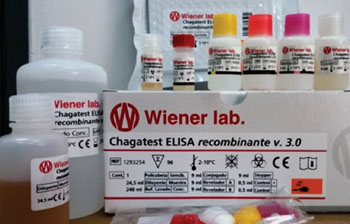Chagas Urine Nanoparticle Test Correlates with Parasitemia Levels
|
By LabMedica International staff writers Posted on 13 Mar 2016 |
Early diagnosis of reactivated Chagas disease in human immunodeficiency virus (HIV) patients could be lifesaving. In Latin America, the diagnosis is made by microscopical detection of the Trypanosoma cruzi parasite in the blood, a diagnostic test that lacks sensitivity.
A novel nanotechnology based on the use of nano-porous particles that contain high affinity chemical baits (trypan blue) in the inner core is proposed for concentration and preservation of antigens in urine. This technology, known as Chagas urine nanoparticle test or Chunap, has been applied in the direct diagnosis of congenital Chagas disease with excellent agreement with standard diagnostic tests.
An international team of scientists led by those at the Universidad Peruana Cayetano Heredia (Lima, Peru) evaluated samples of 31 T. cruzi-infected HIV and 24 T. cruzi uninfected individuals from Cochabamba and Santa Cruz, in Bolivia. Confirmation of T. cruzi infection was based on positive results by two or more of the following commercial tests: Chagatest ELISA and Chagatest ELISA recombinant v 3.0 (Wienner Lab; Rosario, Argentina) and the PolyChaco indirect hemagglutination test (IHA) (Laboratorio Lemos; Buenos Aires, Argentina). Patients were asked to provide the first urine of the day before ingestion of liquids, where midstream specimens were collected. Urinalysis was done using urine test strip.
The concentration of T. cruzi antigens was accomplished using hydrogel nano-porous particles. Electrophoresis and Western Blot analysis of the antigens were performed. Antigen levels were determined by densitometry of western blots. The presence of any of the five diagnostic bands (22 kDa, 42 kDa, 58 kDa, 75 kDa, and 82 kDa) was considered as a positive result. In each experiment they included a negative control, a urine sample of healthy volunteer, and a positive control, 10 mL of healthy volunteer urine sample containing 1 ng of T. cruzi excreted-secreted antigen.
Parasitemia levels in patients with serology positive for Chagas disease were classified as follows: High parasitemia or reactivation of Chagas disease (detectable parasitemia by microscopy), moderate parasitemia (undetectable by microscopy but detectable by quantitative polymerase chain reaction (qPCR), and negative parasitemia (undetectable by microscopy and qPCR). The percentage of positive results detected by Chunap was: 7/7 (100%) in cases of reactivation, 11/12 (91.7%) in cases of moderate parasitemia, and 5/12 (41.7%) in cases of negative parasitemia. Chunap specificity was found to be 91.7%. A cut-off of greater than 105 pg was chosen to determine patients with reactivation of Chagas disease (7/7). Antigenuria levels were 36 times higher in patients with CD4+ lymphocyte counts below 200/mL. The study was published on February 26, 2016, in the journal Public Library of Science Neglected Tropical Diseases.
Related Links:
Universidad Peruana Cayetano Heredia
Wiener Lab
Laboratorio Lemos
A novel nanotechnology based on the use of nano-porous particles that contain high affinity chemical baits (trypan blue) in the inner core is proposed for concentration and preservation of antigens in urine. This technology, known as Chagas urine nanoparticle test or Chunap, has been applied in the direct diagnosis of congenital Chagas disease with excellent agreement with standard diagnostic tests.
An international team of scientists led by those at the Universidad Peruana Cayetano Heredia (Lima, Peru) evaluated samples of 31 T. cruzi-infected HIV and 24 T. cruzi uninfected individuals from Cochabamba and Santa Cruz, in Bolivia. Confirmation of T. cruzi infection was based on positive results by two or more of the following commercial tests: Chagatest ELISA and Chagatest ELISA recombinant v 3.0 (Wienner Lab; Rosario, Argentina) and the PolyChaco indirect hemagglutination test (IHA) (Laboratorio Lemos; Buenos Aires, Argentina). Patients were asked to provide the first urine of the day before ingestion of liquids, where midstream specimens were collected. Urinalysis was done using urine test strip.
The concentration of T. cruzi antigens was accomplished using hydrogel nano-porous particles. Electrophoresis and Western Blot analysis of the antigens were performed. Antigen levels were determined by densitometry of western blots. The presence of any of the five diagnostic bands (22 kDa, 42 kDa, 58 kDa, 75 kDa, and 82 kDa) was considered as a positive result. In each experiment they included a negative control, a urine sample of healthy volunteer, and a positive control, 10 mL of healthy volunteer urine sample containing 1 ng of T. cruzi excreted-secreted antigen.
Parasitemia levels in patients with serology positive for Chagas disease were classified as follows: High parasitemia or reactivation of Chagas disease (detectable parasitemia by microscopy), moderate parasitemia (undetectable by microscopy but detectable by quantitative polymerase chain reaction (qPCR), and negative parasitemia (undetectable by microscopy and qPCR). The percentage of positive results detected by Chunap was: 7/7 (100%) in cases of reactivation, 11/12 (91.7%) in cases of moderate parasitemia, and 5/12 (41.7%) in cases of negative parasitemia. Chunap specificity was found to be 91.7%. A cut-off of greater than 105 pg was chosen to determine patients with reactivation of Chagas disease (7/7). Antigenuria levels were 36 times higher in patients with CD4+ lymphocyte counts below 200/mL. The study was published on February 26, 2016, in the journal Public Library of Science Neglected Tropical Diseases.
Related Links:
Universidad Peruana Cayetano Heredia
Wiener Lab
Laboratorio Lemos
Read the full article by registering today, it's FREE! 

Register now for FREE to LabMedica.com and get access to news and events that shape the world of Clinical Laboratory Medicine. 
- Free digital version edition of LabMedica International sent by email on regular basis
- Free print version of LabMedica International magazine (available only outside USA and Canada).
- Free and unlimited access to back issues of LabMedica International in digital format
- Free LabMedica International Newsletter sent every week containing the latest news
- Free breaking news sent via email
- Free access to Events Calendar
- Free access to LinkXpress new product services
- REGISTRATION IS FREE AND EASY!
Sign in: Registered website members
Sign in: Registered magazine subscribers
Latest Microbiology News
- Handheld Device Delivers Low-Cost TB Results in Less Than One Hour
- New AI-Based Method Improves Diagnosis of Drug-Resistant Infections
- Breakthrough Diagnostic Technology Identifies Bacterial Infections with Almost 100% Accuracy within Three Hours
- Innovative ID/AST System to Help Diagnose Infectious Diseases and Combat AMR
- Gastrointestinal Panel Delivers Rapid Detection of Five Common Bacterial Pathogens for Outpatient Use
- Rapid PCR Testing in ICU Improves Antibiotic Stewardship
- Unique Genetic Signature Predicts Drug Resistance in Bacteria
- Unique Barcoding System Tracks Pneumonia-Causing Bacteria as They Infect Blood Stream
- Rapid Sepsis Diagnostic Test Demonstrates Improved Patient Care and Cost Savings in Hospital Application
- Rapid Diagnostic System to Detect Neonatal Sepsis Within Hours
- Novel Test to Diagnose Bacterial Pneumonia Directly from Whole Blood
- Interferon-γ Release Assay Effective in Patients with COPD Complicated with Pulmonary Tuberculosis
- New Point of Care Tests to Help Reduce Overuse of Antibiotics
- 30-Minute Sepsis Test Differentiates Bacterial Infections, Viral Infections, and Noninfectious Disease
- CRISPR-TB Blood Test to Enable Early Disease Diagnosis and Public Screening
- Syndromic Panel Provides Fast Answers for Outpatient Diagnosis of Gastrointestinal Conditions
Channels
Clinical Chemistry
view channel
‘Brilliantly Luminous’ Nanoscale Chemical Tool to Improve Disease Detection
Thousands of commercially available glowing molecules known as fluorophores are commonly used in medical imaging, disease detection, biomarker tagging, and chemical analysis. They are also integral in... Read more
Low-Cost Portable Screening Test to Transform Kidney Disease Detection
Millions of individuals suffer from kidney disease, which often remains undiagnosed until it has reached a critical stage. This silent epidemic not only diminishes the quality of life for those affected... Read more
New Method Uses Pulsed Infrared Light to Find Cancer's 'Fingerprints' In Blood Plasma
Cancer diagnoses have traditionally relied on invasive or time-consuming procedures like tissue biopsies. Now, new research published in ACS Central Science introduces a method that utilizes pulsed infrared... Read moreMolecular Diagnostics
view channel
New Blood Test Detects 12 Common Cancers Before Symptoms Appear
Bowel cancer is the fourth most common cancer in the UK, with over 42,000 new diagnoses each year. Detecting bowel cancer in its early stages can be challenging, and as the disease progresses, survival... Read more
Blood Test Could Predict Relapse of Autoimmune Blood Vessel Disease
Neutrophils, once believed to be uniform in nature, have been discovered to exhibit significant diversity. These immune cells, which play a crucial role in fighting infections, are also implicated in autoimmune... Read moreHematology
view channel
New Scoring System Predicts Risk of Developing Cancer from Common Blood Disorder
Clonal cytopenia of undetermined significance (CCUS) is a blood disorder commonly found in older adults, characterized by mutations in blood cells and a low blood count, but without any obvious cause or... Read more
Non-Invasive Prenatal Test for Fetal RhD Status Demonstrates 100% Accuracy
In the United States, approximately 15% of pregnant individuals are RhD-negative. However, in about 40% of these cases, the fetus is also RhD-negative, making the administration of RhoGAM unnecessary.... Read moreImmunology
view channel
Stem Cell Test Predicts Treatment Outcome for Patients with Platinum-Resistant Ovarian Cancer
Epithelial ovarian cancer frequently responds to chemotherapy initially, but eventually, the tumor develops resistance to the therapy, leading to regrowth. This resistance is partially due to the activation... Read more
Machine Learning-Enabled Blood Test Predicts Immunotherapy Response in Lymphoma Patients
Chimeric antigen receptor (CAR) T-cell therapy has emerged as one of the most promising recent developments in the treatment of blood cancers. However, over half of non-Hodgkin lymphoma (NHL) patients... Read morePathology
view channel
Sensitive and Specific DUB Enzyme Assay Kits Require Minimal Setup Without Substrate Preparation
Ubiquitination and deubiquitination are two important physiological processes in the ubiquitin-proteasome system, responsible for protein degradation in cells. Deubiquitinating (DUB) enzymes contain around... Read more
World’s First AI Model for Thyroid Cancer Diagnosis Achieves Over 90% Accuracy
Thyroid cancer is one of the most common cancers worldwide, and its precise management typically relies on two primary systems: (1) the 8th edition of the American Joint Committee on Cancer (AJCC) or ... Read more
Breakthrough Diagnostic Approach to Significantly Improve TB Detection
Tuberculosis (TB) remains the deadliest infectious disease globally, with 10.8 million new cases and 1.25 million deaths reported in 2023. Early detection through effective screening is crucial in identifying... Read more
Rapid, Ultra-Sensitive, PCR-Free Detection Method Makes Genetic Analysis More Accessible
Genetic testing has been an important method for detecting infectious diseases, diagnosing early-stage cancer, ensuring food safety, and analyzing environmental DNA. For a long time, polymerase chain reaction... Read moreTechnology
view channel
Disposable Microchip Technology Could Selectively Detect HIV in Whole Blood Samples
As of the end of 2023, approximately 40 million people globally were living with HIV, and around 630,000 individuals died from AIDS-related illnesses that same year. Despite a substantial decline in deaths... Read more
Pain-On-A-Chip Microfluidic Device Determines Types of Chronic Pain from Blood Samples
Chronic pain is a widespread condition that remains difficult to manage, and existing clinical methods for its treatment rely largely on self-reporting, which can be subjective and especially problematic... Read more
Innovative, Label-Free Ratiometric Fluorosensor Enables More Sensitive Viral RNA Detection
Viruses present a major global health risk, as demonstrated by recent pandemics, making early detection and identification essential for preventing new outbreaks. While traditional detection methods are... Read moreIndustry
view channel
Cepheid and Oxford Nanopore Technologies Partner on Advancing Automated Sequencing-Based Solutions
Cepheid (Sunnyvale, CA, USA), a leading molecular diagnostics company, and Oxford Nanopore Technologies (Oxford, UK), the company behind a new generation of sequencing-based molecular analysis technologies,... Read more
Grifols and Tecan’s IBL Collaborate on Advanced Biomarker Panels
Grifols (Barcelona, Spain), one of the world’s leading producers of plasma-derived medicines and innovative diagnostic solutions, is expanding its offer in clinical diagnostics through a strategic partnership... Read more






















